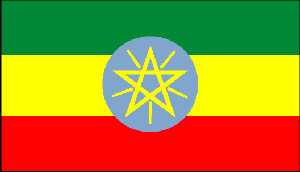
|
Ethiopia
Background:
Unique among African countries, the ancient Ethiopian monarchy maintained its
freedom from colonial rule, one exception being the Italian occupation of
1936-41. In 1974 a military junta, the Derg, deposed Emperor Haile Selassie
(who had ruled since 1930) and established a socialist state. Torn by bloody
coups, uprisings, wide-scale drought, and massive refugee problems, the regime
was finally toppled by a coalition of rebel forces, the Ethiopian People's
Revolutionary Democratic Front (EPRDF), in 1991. A constitution was adopted in
1994 and Ethiopia's first multiparty elections were held in 1995. A two and a
half year border war with Eritrea ended with a peace treaty on 12 December 2000.
Location:
Eastern Africa, west of Somalia.
Area: Total: 1,127,127 sq km, water: 7,444 sq km, land: 1,119,683 sq km.
Area - comparative: Slightly less than twice the size of Texas.
Land boundaries: Total: 5,328 km, border countries: Djibouti 349 km, Eritrea
912 km, Kenya 861 km, Somalia 1,600 km, Sudan 1,606 km.
Coastline: 0 km (landlocked).
Climate and Terrain:
Climate: Tropical monsoon with wide topographic-induced variation.
Terrain: High plateau with central mountain range divided by Great Rift Valle.
Natural resources: Small reserves of gold, platinum, copper, potash, natural
gas, hydropower.
People:
Population: 67,673,031.
Ethnic groups: Oromo 40%, Amhara and Tigre 32%, Sidamo 9%, Shankella 6%, Somali
6%, Afar 4%, Gurage 2%, other 1%.
Religions: Muslim 45%-50%, Ethiopian Orthodox 35%-40%, animist 12%, other
3%-8%.
Languages: Amharic, Tigrinya, Oromigna, Guaragigna, Somali, Arabic, other local
languages, English (major foreign language taught in schools).
Government:
Government type: Federal republic.
Capital: Addis Ababa.
Independence: Oldest independent country in Africa and one of the oldest in the
world - at least 2,000 years.
Economy overview:
National holiday: National Day (defeat of MENGISTU regime), 28 May (1991)
Ethiopia's poverty-stricken economy is based on agriculture, which accounts for
half of GDP, 85% of exports, and 80% of total employment. The agricultural
sector suffers from frequent drought and poor cultivation practices, and as
many as 4.6 million people need food assistance annually. Coffee is critical to
the Ethiopian economy with exports of some $260 million in 2000. Other
important exports include qat, live animals, hides, and gold. The war with
Eritrea in 1999-2000 and recurrent drought have buffeted the economy, in
particular coffee production.
Statistics:
Telephones - main lines in use: 231,900.
Telephones - mobile cellular: 17,800.
Radio broadcast stations: AM 8, FM 0.
Radios: 15.2 million.
Television broadcast stations: 1 plus 24 repeaters.
Televisions: 682,000.
Internet users: 20,000.
Railways: Total: 681 km.
Highways: Total: 24,145 km, paved: 3,290 km, unpaved: 20,855 km.
Airports: 86,
with paved runways: 14,
with unpaved runways: 72.
Return to Visiting Locations
|

